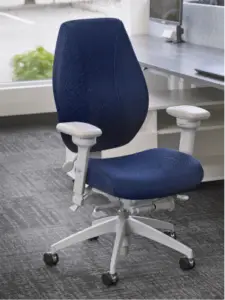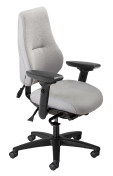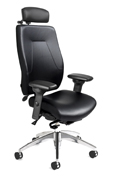
Should I use an Exercise Ball when performing seated work?

Geoff Wright serves on the CSA Z412-17 Technical Committee as the representative of the Association of Canadian Ergonomists/Association Canadienne d’Ergonomie. He is a Professional Engineer (P. Eng.) with a Ph. D. in Ergonomics, a Canadian Registered Safety Professional (CRSP) and a Certified Professional Ergonomist in Canada (CCPE), the USA (CPE), and the U K (F. Erg. S).
Most of us are familiar with exercise balls (also commonly referred to as a fitness ball, stability ball or a Swiss ball). Usually we see them in a local exercise or rehabilitation facility. You may have one at home and wonder if you should use it to sit on while working at a desk.
The advice I always provide is:
“it is not appropriate for an employee to use an exercise ball as a seat when performing computer-based work at a desk or a computer workstation”.
An exercise ball does not provide a stable base, allow for movement within the work space, have a backrest to support the lumbar region of the spine, and could contribute to physical discomfort for an employee who is working at a desk or computer workstation.
The ergonomics perspective on why an exercise ball is not a replacement for a work chair is outlined below.
Need for Stability
The Business and Institutional Furniture Manufacturers Association (BIFMA) G1-2013 (“Ergonomics Guideline for Furniture used in Office Work Spaces Designed for Computer Use”) is very specific on the need for stability. This guideline states that the purpose of well-designed seating is to provide stable support. Similarly, the Canadian Standards Association (CSA) Standard Z412-17 – An application standard for workplace ergonomics – requires that the legs of the work chair ensure stability.
One obvious reason for this requirement is that there are hard objects and sharp corners in an office environment that present a real risk of injury if one unexpectedly loses their balance while seated.
In comparison, when you sit on an exercise ball you quickly realize that it is inherently unstable. While exercise rooms use soft mats on the floor, office environments do not!
Movement within the work space
A work chair swivels so that the seated user can get close to equipment, accessories, and/or reach materials. The swivel also makes it safer and provides easier access when sitting down or getting up out of the chair.
In comparison, exercise balls are not intended for moving around within a work space. When seated on an exercise ball you need to be actively aware of your posture and balance all of the time. This is especially true when getting on or off the exercise ball.
A backrest is an essential requirement
The CSA Standard on Office Ergonomics (Z412-17) includes the requirement that an office task chair have a backrest that provides adequate back/lumbar support.
A chair that provides adequate lumbar support helps maintain the natural inward curvature of the spine in the lower back. This posture is recommended as it distributes pressure within the intervertebral discs in the spine and helps minimizes back strain.
A backrest that provides adequate back/lumbar support is an important feature for a work chair since, if an employee decides to remain seated for prolonged periods of time, back pain and/or injury can occur when this inward curvature in the lower back/lumbar region of the spine is not achieved.
Could Contribute to Physical Discomfort
On a work chair the height of the seat is easily adjusted and the range in the adjustment in the height of the seat accommodates most users.
In comparison to the work chair, the exercise ball is selected so it is appropriate for the person’s height/leg length. Also, the exercise ball needs to be inflated correctly for the person using it. However, even when it is inflated correctly your height when seated on the exercise ball may not raise you up high enough for the work surface that the computer’s keyboard and mouse is placed on. Raising your shoulders, arms and/or hands to reach the keyboard and mouse will result in musculoskeletal discomfort and injury.
Summary
Manufacturers have spent many years in developing and enhancing the features designed into a work chair to ensure their products meet the recommendations specified by BIFMA and the CSA. The requirements specified in BIFMA G1 and CSA Z412-17 are consistent with the ergonomics perspective on why an exercise ball is not a replacement for a work chair when performing computer-based work at a desk or a computer workstation.
Disclaimer
The views and professional opinions expressed in this article are those of Geoff Wright and do not necessarily reflect the opinion or views of any organizations that Geoff Wright may be associated or affiliated with. It is intended solely for educational purposes and is written to give general information and provide a general understanding of ergonomics. Every attempt is made to ensure accuracy and reliability of the information provided. The information may not be applicable or suitable to your circumstances and should not be a substitute for advice from a certified professional ergonomist and/or other qualified professionals.
Download PDF
Now it’s your turn to ask an expert!
If you have a question about office ergonomics, please fill in the form below.
If the question is of general interest, the question and your general location (but not your name) will be posted on our website along with a brief answer. The response may simply state that the topic will be covered in a subsequent article. Health or medical advice is not provided. In some cases you may receive a personal response.








